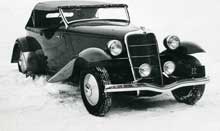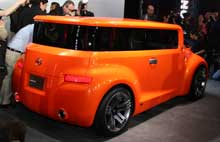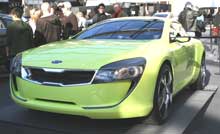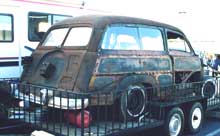Edsel's Third Special
The blogs have been agog since Edsel Ford's Special Speedster made $1.76 million at RM's recent Amelia Island auction. The notoriety is well deserved, since the car lay unnoticed in a Florida lockup until re-discovered and restored by Amelia Island Concours founder Bill Warner. Perhaps more to the point, it aroused interest in Edsel's other specials and reminded the pundits that his first speedster, too, is back in the spotlight, having appeared at the 2007 Grand National Roadster Show.
Throughout this fray has come occasional mention of Edsel's third special, and PreWarCar.com's Rutger Booy wondered if it, too, might soon be found. I doubt it.
The third special, known as the Special Sports, has long been misunderstood. Occasionally thought to be a British Jensen because of its right-hand drive, it was instead the starting point for Jensen's own cars, but done in Dearborn under Bob Gregorie's direction for Edsel himself. Built late in 1934, it adopted the chassis details of the Special Speedster, extended front axle and underslung rear, but instead of a speedster body it carried a four-place, two-door tourer. Edsel wanted to put it into limited production but his father said "No!" Edsel and Gregorie tried to interest the foundering coachbuilder Brewster, but nothing came of it.
Instead, the concept was floated across the Atlantic to Ford's British subsidiary. Ford of Britain boss Percival Perry didn't like the idea either, but the Jensen brothers, who had built a Ford-based special for the 1934 Tourist Trophy race in Ireland, did. They had been rebodying Ford V8s into sleek tourers with English appointments, a few of which made it to the US. One of these, a 1936 model, was intended for Clark Gable, who cancelled his order before delivery. Gable did, however, pose for publicity with other Jensen-Fords.
Edsel had Gregorie put together another Special Sports chassis, this time without the underslung rear, since the 1935 Fords sat lower in stock form. The Jensens then began building to this pattern, but added their own coachbuilt body with distinctive radiator shell and interior appointments. A neat remote shifter was included. Sold as the "3-1/2 Litre Jensen" it used the 21-stud V8 with SU carb and came in saloon, tourer and drophead coupe forms. These cars, introduced in the autumn of 1936, are commonly called S-Types, from their serial numbers.
Late in 1937, the Jensens beefed up the front of the Ford chassis and dropped in a Nash dual-ignition straight eight. The cars had a novel independent front suspension using over-and-under leaf springs as control arms - described by some owners as "too independent." Designated "4-1/4 Litre Straight Eight" they were nicknamed "H-Types" and came in the same saloon, tourer and drophead styles. A limousine was cataloged but probably never built. One car was constructed in left-hand drive form with a Lincoln-Zephyr V-12. Perhaps 50 S-Types and a dozen H-Types were built before World War II put a halt to production. Jensen was coy about the Ford (and Nash) content, which grieved Edsel but placated both his father and Percival Perry.
Will the real Special Sports turn up some day? Perhaps, but if so it will have been well hidden. It was last seen in the 1950s on a Burbank, California, used car lot wearing a LaSalle grille and a Carson padded top.
The full story of this English intrigue, told by the historian who connected the dots, can be read in Automobile Quarterly Vol. 36 No. 2 (February 1997).




